Travel to Hyderabad
Air: Hyderabad is well connected to national and international destinations with both national and international air carriers.
If you are arriving by one of the international flights that directly connect to Hyderabad, you will arrive at the International Terminal and go through the necessary Immigration and Customs formalities. Connecting flights from domestic destinations arrive at the Domestic Terminal.
Flights from Major International Destinations to Hyderabad
|
Please Note: Flight schedules are subject to change, please call the Rajiv Gandhi International Airport, Hyderabad India to check current flight schedules
![]()
Travel Desk
For the travel needs of patients, Sindoori Travels is operating a Travel Desk in the main lobby of the Hospital. For all domestic, international air ticketing, Visas, Passports and Railway reservations contact: Miss Manju Masih Phone : 23607777, Extn : 4450,
Ms. Avanti Reddy Cell : 98480-17277
![]()
About Hyderabad
|
Population |
6.4 Million |
|
Total Area |
1864 sq. km |
|
Latitudes |
17o 20′ N |
|
Longitude |
78o 30′ E |
|
Altitude |
536 m |
![]()
History
Hyderabad, the capital city of Andhra Pradesh consists of the twin cities of Hyderabad and Secunderabad and is a bustling 400-year-old metropolis with an urban population of 6 million people approximately. Hyderabad is famous as the former seat of the fabulously wealthy Nizams of Hyderabad. Built on the banks of the river Musi, and surrounded by huge prehistoric rock formations like petrified, gray elephants, Hyderabad is a blend of the fairy tale and earthy, a pot pourri of old and new.
Hyderabad, India’s fifth-largest city was founded in 1590 by Muhammad Quli, the fourth of the Qutb Shahi kings. They ruled this part of the Deccan from 1512 until 1687. Before founding Hyderabad, the Qutab Shahi kings ruled from the forted city of Golconda, 11 km to the west. After Aurangzeb’s death in 1707, Mughal control over this part of India rapidly waned and the Asaf Jahi viceroys who had been installed to look after the interests of the Mughal Empire broke away to establish their own independent state. They gave themselves the titles ‘subedar’ and ‘nizam’.
In 1798, a subsidiary alliance for military and political cooperation was signed between the Nizam and the British East India Company. Thereafter an area north of what is now the Hussain Sagar Lake was established as a cantonment. The area was named Secunderabad after the then Nizam, Sikander Jah. Both Hyderabad and Secunderabad grew together and have now merged. An imaginary line drawn across the Tank bund is still used to distinguish the two cities. Hyderabad is among the few Indian cities, which has a well-preserved cultural heritage. Hyderabad invokes nostalgia among old residents for its culture, fine arts and certain sophistication in manners. Much more than anything, Hyderabad presents a true picture of secularism.
Hyderabad is the fifth largest cosmopolitan city in India, rich in culture, enduring history and industrial growth. It is unique in being one of the few cities where tradition and technology co-exist. With a dynamic leadership, the state is steering the nation to new dimensions in the fields of Information Technology, Biotechnology, Pharmaceuticals, and Business Management to emerge as a city of immense business opportunities.
![]()
Charminar: 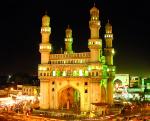
The Charminar is as much the signature of Hyderabad as the Taj Mahal is of Agra or the Eiffel Tower is of Paris. Mohammed Quli Qutb Shah, the founder of Hyderabad, built Charminar in 1591 at the centre of the original city layout. It was said to be built as a charm to ward off a deadly epidemic raging at that time. Four graceful minarets soar to a height of 48.7m. above the ground. Charminar has 45 prayer spaces and a mosque in it. Visitors can view the architectural splendour inside the Charminar. The monument is illuminated in the evenings and a pedestrianisation project around the monument is under implementation.
Golconda Fort: 
Golconda is one of the famous forts of India. The name originates from the Telugu words “Golla Konda” meaning “Shepherd’s Hill”. The origins of the fort can be traced back to the Yadava dynasty of Deogiri and the Kakatiyas of Warangal. Golconda was originally a mud fort, which passed to the Bahmani dynasty and later to the Qutb Shahis, who held it from 1518 to 1687 A.D. The first three Qutb Shahi kings rebuilt Golconda, over a span of 62 years. The fort is famous for its acoustics, palaces, ingenious water supply system and the famous Fateh Rahben gun, one of the cannons used in the last siege of Golconda by Aurangzeb, to whom the fort ultimately fell.
Sound & Light Show at Golconda Fort
The glorious past of Golconda Fort is narrated effectively with matchless Sound and Light effects. The unique Sound & Light Show takes you right back in time, when Golconda was full of life, glory and grandeur.
Qutb Shahi Tombs: 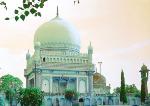
The tombs of the legendary Qutb Shahi kings lie about a kilometre away from Banjara Darwaza of the Golconda Fort. Planned and built by the Qutb Shahis themselves, these tombs are said to be the oldest historical monuments in Hyderabad. They form a large group and stand on a raised platform. The tombs are built in Persian, Pathan and Hindu architectural styles using grey granite, with stucco ornamentation, the only one of its kind in the world where an entire dynasty has been buried at one place.
Mecca Masjid: 
A two hundred yards southwest of the Charminar is the Mecca Masjid, so named because the bricks were brought from Mecca to build the central arch. The Qutb Shahis never finished the building of the mosque, which was completed by Aurangzeb in 1694. Mecca Masjid is poetry in stone, with a hall measuring 67m and soaring to a height of 54m. Fifteen graceful arches – five to each of the three sides, support the roof. Towards the southern end of the mosque lie the marble graves of members of the Asaf Jahi dynasty.
Birla Mandir: 
This white marble temple of Lord Venkateshwara floats on the city skyline, on Kala Pahad. The idol in the temple is a replica of the one at Tirupati.
Salar Jung Museum: 
This museum houses one of the biggest one-man collections of antiques of the world by Mir Yousuf Ali Khan, Salar Jung III. The objects d’art include Persian carpets, Moghal miniatures, Chinese porcelain, Japanese lacquerware, famous statues including the Veiled Rebecca and Marguerite and Mephistopheles, a superb collection of jade, daggers belonging to Queen Noor Jahan and the Emperors Jahangir and Shah Jahan, Aurangzeb’s sword and many other fabulous items.
Andhra Pradesh State Archaeological Museum: 
A visit to the Andhra Pradesh State Archaeological Museum is a delight for art lovers. Located in the picturesque Public Gardens, the museum boasts of one of the richest repositories of antiques and art objects in the country. Built in 1920 by the Nizam VII, the museum building itself is a fine example of Indo-Saracenic architecture. The museum contains a Buddhist gallery, Brahmanical & Jain gallery, Bronze gallery, Arms & Armour gallery, Numismatics gallery, Ajanta gallery and more. Adjacent to the State Museum is the Contemporary Art Museum.
The Nizam‘s Silver Jubilee Museum:
The stately Purani Haveli, the palace acquired around the year 1750 by the second Nizam, is now converted into a museum with a fascinating collection. The museum exhibits the gifts and mementos presented to the last Nizam on the occasion of the silver jubilee celebrations in 1937. A 1930 Rolls Royce, Packard and a Mark V Jaguar are among the vintage cars displayed. There is an interesting collection of models made in silver of all the prominent buildings of the city and citations in Urdu about H.E.H. Mir Osman Ali Khan, gold burnished wooden throne used for the silver jubilee celebrations, gold tiffin box inlaid with diamonds, and a gold model of Jubilee Pavilion.
Birla Planetarium/Birla Science Museum:
Birla Planetarium is India’s most modern planetarium and first of its kind in the country. It is equipped with advanced technology from Japan and is built on Naubat Pahad adjacent to Kala Pahad. And the Science Museum stands tribute to the advancement achieved by Science and Technology.
Chow Mohalla Complex: 
Built in several phases by the Nizams between 1857-1869, this is now one of the heritage buildings. The complex comprises four palaces in Moghal and European styles, of which the main palace is double storeyed with the others being single-storeyed blocks.
Nehru Zoological Park: 
Spanning 300 lush green acres, the Nehru Zoological Park is a must for nature lovers. It has over 250 species of animals and birds, most of which are kept in conditions as close to their natural habitats as possible. This is the first zoo to create moated enclosures for animals. The Lion Safari Park, Natural History Museum and Children’s Train are the added attractions. APTDC runs an ice-cream parlour and restaurant here.
Shilparamam – The Arts & Crafts village: 
Another attraction at Madhapur beyond Jubilee Hills in Hyderabad is the 30-acre village, which showcases arts and crafts of the country. India is an ocean of various arts and crafts but the talent of most of the artisans and artists goes unrecognized. To encourage them and give the necessary boost to their art, the crafts village hosts annual bazaars, where artists and artisans from all over the country exhibit their talent.
Public Gardens
Hyderabad has several beautiful gardens, one of the most popular being the Public Gardens, which also encloses the State Legislature, State Archaeological Museum, Jubilee Hall, Jawahar Bal Bhavan and Telugu Lalita Kala Thoranam, an open-air theatre.
Boating: AP Tourism operates pedal boats in Public Gardens pond.
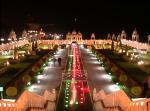 Ramoji Film City:
Ramoji Film City:
A dream world created for the celluloid on a sprawling 1000 acres, with every imaginable set and location, Ramoji Film City on the outskirts of Hyderabad offers facilities to produce any kind of movie. Apart from sets, there are hotels where artistes and technicians can stay. Visitors too can go round in conducted tours that the management organises.
Hitec City:
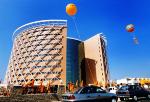 One of the modern monuments of trade and technology, it embodies the newfound attitude of Hyderabad and today finds a place of pride. Situated on the outskirts of the city, it is the nucleus of Cyberabad, the IT destination in this part of the world. Cyber Towers is the main building here.
One of the modern monuments of trade and technology, it embodies the newfound attitude of Hyderabad and today finds a place of pride. Situated on the outskirts of the city, it is the nucleus of Cyberabad, the IT destination in this part of the world. Cyber Towers is the main building here.
Lumbini Park:
 This beautiful entertainment park is situated on the shore of Hussainsagar lake. The landscaping here is a visual treat. A musically synchronized water fountain and a floral clock are major attractions here. Lumbini Park jetty is a major point for pleasure boating of AP Tourism.
This beautiful entertainment park is situated on the shore of Hussainsagar lake. The landscaping here is a visual treat. A musically synchronized water fountain and a floral clock are major attractions here. Lumbini Park jetty is a major point for pleasure boating of AP Tourism.
Hyderabad Botanical Gardens:
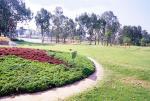 The first Botanical Gardens in Andhra Pradesh, spread over 120 acres. Already open to public is the first phase, with the completion of some sections. The sections include medicinal plants, timber trees, fruit trees, ornamental plants, aquatic plants and bamboos. The Park has been designed to have large water bodies, rolling meadows, natural forests, rich grasslands and exquisite rock formations.
The first Botanical Gardens in Andhra Pradesh, spread over 120 acres. Already open to public is the first phase, with the completion of some sections. The sections include medicinal plants, timber trees, fruit trees, ornamental plants, aquatic plants and bamboos. The Park has been designed to have large water bodies, rolling meadows, natural forests, rich grasslands and exquisite rock formations.
Hussainsagar Lake:
 Excavated in 1562 A.D. by Hussain Shah Wali during the time of Ibrahim Quli Qutb Shah, the lake has a promenade that is a busy thoroughfare today. Boating and water sports are a regular feature in the Hussainsagar. One of the World’s tallest monolithic statues of the Buddha stands on the ‘Rock of Gibraltar’, in the middle of the lake.
Excavated in 1562 A.D. by Hussain Shah Wali during the time of Ibrahim Quli Qutb Shah, the lake has a promenade that is a busy thoroughfare today. Boating and water sports are a regular feature in the Hussainsagar. One of the World’s tallest monolithic statues of the Buddha stands on the ‘Rock of Gibraltar’, in the middle of the lake.
Added to all these, AP Tourism has additional boating facilities like speed boats, motor boats, 48 seater launch etc. Starlit dinner on-board and private parties also can be arranged on the Launch.
Osmansagar Lake: 
Osmansagar, better known as Gandipet, on the outskirts of Hyderabad is an excellent picnic spot. Osmansagar is one of the two lakes on the city’s periphery that supplies drinking water to the great metropolis. The lake is a reservoir created by a dam across the Isa, a tributary of the River Musi. Abutting the lake and the bund are lush gardens that provide the ideal ambience for an outing. Overlooking the lake is the heritage building, Sagar Mahal, built as a resort by the Nizam of Hyderabad and converted now into a lake resort managed by AP Tourism.
Shamirpet:
Located 24 km to the north of Secunderabad, Shamirpet has a beautiful lake and a deer park. Its peaceful environs make it a great picnic spot. AP Tourism offers comfortable cottage facilities for accommodation, while the forest lodges can be booked with the AP Forest Department office at Saifabad.
Tourist Cottages.
Mir Alam Tank:
Mir Alam Tank is a large lake adjacent to Nehru Zoological Park. AP Tourism operates boats on the lake, for which one has to enter through the Zoo.
Secret Lake (Durgam Cheruvu): 
The ‘Secret Lake’ is situated close to Shilparamam Crafts Village and Hitec City, behind Jubilee Hills. AP Tourism organizes boating in the lake. ‘Something Fishy’, a bar Secret Lake (Durgam Cheruvu)
KBR National Park:
One of the largest parks within the city KBR National Park is a Southern tropical deciduous forest and the last vestigial representative of the endemic flora of Hyderabad region, with over 100 species of birds, 20 species of reptiles and 15 species of butterflies.
Mrugavani National Park (Chilkur):
Located 25 km. from Hyderabad, the park contains the endemic flora of Hyderabad and is an urban refuge for small mammals like wildboar, jungle cat etc. and birds.
Mahavir Harina Vanasthali National Park:
Located 15 Km. from Hyderabad, the park has more than 350 black bucks, 400 cheetals and a number of wild boars, small mammals, reptiles and over 100 species of
birds.
 Snow World:
Snow World:
It is the World’s biggest and India’s 1st Snow Theme Park. The visitors can chill out at minus 5°C and go merry with SNOW and have a SNOW-FILLED fun holiday. The Snw Park has achieved yet another milestone by introducing Snow Fall, this is the first of its kind of Snow Fall introduced by any Snow Theme Park or Snow Dome anywhere in the world. Slide and skate on ice and throw snowballs at each other, Enjoy India’s first snow park.
Tel: +91-040-27677948, Website: www.snowworldindia.com
![]()
Hyderabadi Cuisine
Hyderabad was known for the spectacular way its aristocracy entertained. Some of the salient features of Hyderabadi food are the key flavours of coconut, tamarind, peanuts and sesame seeds. This cuisine owes its origins to the Mughalai style of cooking of the Asaf Jahi period. By carefully mellowing and nurturing the typical Mughalai flavors with a blend of spices, the cuisine of Hyderabad was born. While there is a certain exotic quality to some of the royal foods, it is also known that a true Hyderabadi will go anywhere in the city for a well prepared dish, however humble its origin.
 For those who want a taste of the royal menu, there is a variety of Biryanis (A rice and meat preparation, seasoned with spices and flavorings); kababs (meat pieces of minced meat cooked in many different styles such as Boti, Jhammi, Kalmi, Shikampur, Sheek, Legan – ke – kababs, Dum – ke- kababs); Khormas (either meat or vegetables cooked in a rich creamy gravy) and Lukhmi (pastry). During the month of Ramzan, one gets to taste Haleem (a pounded wheat and meat preparation). For those who prefer more homely food, there is Kichri (a rice and lentil preparation); Kheema methi (minced meat with fenugreek); Nahari (a stew of tongue and lamb trotters); Rumali Rotis (bread as thin as a handkerchief) and chakna (a spicy dish of meat).
For those who want a taste of the royal menu, there is a variety of Biryanis (A rice and meat preparation, seasoned with spices and flavorings); kababs (meat pieces of minced meat cooked in many different styles such as Boti, Jhammi, Kalmi, Shikampur, Sheek, Legan – ke – kababs, Dum – ke- kababs); Khormas (either meat or vegetables cooked in a rich creamy gravy) and Lukhmi (pastry). During the month of Ramzan, one gets to taste Haleem (a pounded wheat and meat preparation). For those who prefer more homely food, there is Kichri (a rice and lentil preparation); Kheema methi (minced meat with fenugreek); Nahari (a stew of tongue and lamb trotters); Rumali Rotis (bread as thin as a handkerchief) and chakna (a spicy dish of meat).
For the vegetarians there is Bagara Baingan (a rich spicy preparation of aubergines); Mirch-ka-salan (chillies in a creamy gravy); Tomato kut (aromatic puree of tomato with flavorings); and Shahi dahi vadas (lentil dumplings in yogurt sauce).
![]()
Things to do
Eating Out
For a comprehensive list of Restaurants, Hangouts, Events, and Services and Shopping Directory of Hyderabad, please check
http://timescity.com/hyderabad
Museums
Salar Jung Museum
B.M. Birla Science & Technological Museum
H.E.H The Nizam’s Museum
Qutub Shahi Tombs Site Museum
![]()
